Properties of High-Performance Materials for the Crack Repair of Segment Structures
Abstract
:1. Introduction
2. Raw Materials and Test Methods
2.1. Test Raw Materials
2.2. Test Method
- (1)
- Setting time: Refer to the requirements of DL/T 5126-2021 [17] “polymer modified cement mortar test procedure” [18]. The time of starting to add water was the starting time of the setting time, and the initial setting was that the test needle sank to 2–3 mm from the bottom plate. The final setting was that the settlement of the test needle did not exceed 0.5~1 mm. The initial setting and final setting times were calculated from the beginning of adding water to the initial setting and final setting states and expressed as h (hour) and min (minute).
- (2)
- Compressive and flexural strength: The test was based on GB/T 17671-2021 [19] “Cement mortar strength test method (ISO method)” requirements [20]. The test results were obtained by breaking a set of three prisms to obtain the average compressive strength of the six specimens, and the results were kept at 0.1 MPa.
- (3)
- Bonding flexural strength test: According to GB/T 17671-2021 [19] “Cement mortar strength test method (ISO method)”, after 28 days of curing, the specimen was broken. Half of the samples were put into the test mold, and the modified cement mortar was injected into the remaining half of the test mold. The specimens bonded to the modified mortar and the original cement mortar were cured to 7 days and 28 days, after which the flexural strength was tested. The flexural strength of the specimen was used to describe the bonding performance of the polymer-emulsion-modified cement mortar [21].
- (4)
- Infrared spectroscopy analysis: The polymer was fully stirred with a certain amount of methanol, and the graft and monomer copolymer were completely precipitated, filtered, washed, and vacuum-dried to constant weight [22]. Then it was extracted with isopropanol in a Soxhlet extractor to remove the monomer copolymer and dried to constant weight. The purified resin was coated on the pressed KBr, dried under an infrared lamp for 10 min, and tested using a Fourier transform infrared spectrometer (NEXUS670, Nicolet, Nicolet Instruments, Inc., Madison, WI, USA).
- (5)
- XRD test: The broken repair material was a small particle with a diameter of 1~2 mm, determined using a diamond thermogravimetric/differential thermal analyzer, produced by PERKIN-ELMER company in the United States. The sample was placed at (30~700) °C, and the heating rate was 10 °C/min for the TG and DTA tests [23].
- (6)
- Optical microscope analysis method: According to the requirements of DL/T 5126-2021 [17] “Polymer Modified Cement Mortar Test Procedure”, a series of observation and analysis steps were taken in the evaluation and research of the repair materials. Firstly, a small test block of 10 mm × 10 mm × 10 mm was intercepted from the repair material, and the section was observed. By observing the cross section of the test block, the uniformity and density of the repair material and the quality and integrity of the bonding interface with the mortar were evaluated. Then, the cutting surface of the test block was analyzed using an optical microscope, focusing on the pore structure in order to understand the key parameters such as porosity, pore distribution, and connectivity of the repair material. Through the study of pore structure, the quality of repair materials can be evaluated, and the formulation and properties of materials can be further improved and optimized [24].
- (7)
- Scanning electron microscopy (SEM): According to the requirements of DL/T 5126-2021 [17] “Test Specification for Polymer Modified Cement Mortar”, a small test block of about 10 mm × 10 mm × 5 mm was intercepted. The section of the small test block and the bonding surface between the repair material and the original matrix mortar were observed via electron microscope. The uniformity, compactness, and internal structure of the repair material were evaluated, and the bonding quality and bonding strength were judged.
2.3. Optimization Design of Concrete Segment Crack Repair Material
3. Research of the Microstructure of Crack Repair Materials
3.1. Infrared Spectroscopic Analysis of Crack Repair Materials
3.2. SEM Analysis of Crack Repair Materials
3.3. X-ray Diffraction Analysis of Crack Repair Materials
3.4. Analysis of Surface Morphology of Crack Repair Materials
4. Study of the Properties of the Segment Crack Repair Materials
4.1. Study of the Physical Properties of the Segment Crack Repair Materials
4.1.1. Study of the Fluidity of Crack Repair Materials
4.1.2. Study of the Setting Time of Crack Repair Materials
4.2. Study of the Mechanics and Deformation Properties of Crack Repair Materials
4.2.1. Study of Compression and Folding Strength of Crack Repair Materials
4.2.2. Binding and Tensile Strength of Crack Repair Materials
5. Conclusions
- (1)
- From the results of infrared spectroscopy, it can be found that the Ca-containing complex produced by the epoxy polymer when the curing reaction is completed can fill the capillary pores in the cement paste and improve the capillary pore structure. The addition of epoxy polymer can improve the strength and compactness of cement stone;
- (2)
- The thickness of the epoxy polymer film increases with the increase in polymer, and the bonding tensile strength increases first and then decreases with the increase in polymer. The water–cement ratio can also affect the film formation of the epoxy polymer;
- (3)
- The results of X-ray diffraction show that epoxy polymer can effectively promote the hydration of cement, and the polymer–cement ratio can be appropriately increased in the repair material;
- (4)
- After the reaction of cementitious material and cement mortar, the density and strength of the polymer repair material for 28 days are improved to a certain extent, and the deformation of the polymer repair material is reduced. Therefore, adding appropriate cementitious material to the repair material can enhance the repair effect of the repair material;
- (5)
- The fluidity of the repair material increases with the increase in the polymer–cement ratio, and the greater the water–cement ratio is, the greater the fluidity is. When the polymer–cement ratio is 0.07, the water–cement ratio is 0.28, the sand–cement ratio is 1.5, and the solid–polymer ratio is 0.6, the fluidity of the repair material is the best;
- (6)
- The 28-day flexural strength of polymer repair materials (except when the water–cement ratio is 0.3 and the polymer-cement ratio is 0.08) is higher than that of ordinary cement mortar, and the increase is about 5−10%, but the 7-day flexural strength is lower than that of ordinary cement mortar. When the water–cement ratio is 0.24 or 0.26, the flexural strength of the polymer–cement ratio 0.05 is the highest, but when the water–cement ratio is 0.28, the flexural strength of the polymer–cement ratio 0.03 is the highest;
- (7)
- The bonding flexural strength of epoxy polymer repair material is greatly improved compared to that of ordinary mortar. Whether the base is concrete or mortar, the bonding flexural strength is the highest when the polymer–cement ratio is 0.07, the water–cement ratio is 0.28, the sand–cement ratio is 1.5, and the solid–polymer ratio is 0.6;
- (8)
- In both wet and dry situations, the repair material’s bonding tensile strength is greater than that of regular mortar. The bonding tensile strength rose initially and subsequently fell as the epoxy polymer content rose. In addition, the bonding tensile strength in a damp environment is lower than in a dry one. The inclusion of epoxy polymer can greatly enhance the bonding ability of the repair material, allowing the solid polymerization ratio to be raised to 0.6. This is because epoxy polymer paste and mortar are less susceptible to moisture than regular cement paste and mortar.
Author Contributions
Funding
Institutional Review Board Statement
Informed Consent Statement
Data Availability Statement
Conflicts of Interest
References
- Chen, M.; Gao, P.; Geng, F.; Xu, S.-Y.; Chen, X. Mechanical and smart properties of carbon fiber and graphite conductive concrete for internal damage monitoring of structure. Constr. Build. Mater. 2017, 142, 320–327. [Google Scholar] [CrossRef]
- Eng, T.Z.; Gao, P.; Zhu, Q.; Zhu, A. Experimental and Numerical Modeling on FRP and PM Confinement Tilt Fulcrum RC Segments under Humid and Fatigue Conditions. KSCE J. Civ. Eng. 2019, 23, 3409–3419. [Google Scholar] [CrossRef]
- Toshinori, K.; Satoshi, T. Applicability of AC impedance method for measuring time-variant corrosion rate to cracked and crack-repaired reinforced concrete. Mater. Struct. 2023, 56, 20. [Google Scholar]
- Gao, P.; Lu, X.; Yan, Y.; Dong, B.; Li, X. Effect of composite mineral admixtures on restraining alkali-silica reaction. J. Nanjing Univ. Aeronaut. Astronaut. 2006, 23, 120–124. (In English) [Google Scholar]
- Camille, A.; Pauls, D. Experimental study of epoxy repairing of cracks in concrete. Constr. Build. Mater. 2007, 1, 157–163. [Google Scholar]
- Houli, X. Study on Preparation and Properties of New Bonding Mortar. Master’s Thesis, Chongqing University, Chongqing, China, 2001. [Google Scholar]
- Sumaiya, A.; Dieu, N.Q.; Arnaud, C. Evaluation of cracking potential parameters for low to high grade concrete with fly ash or slag. Constr. Build. Mater. 2022, 350, 128891. [Google Scholar]
- Liu, Q.; Hu, Z.; Wang, X.; Zhao, H.; Qian, K.; Li, L.; Meng, Z. Numerical study on cracking and its effect on chloride transport in concrete subjected to external load. Constr. Build. Mater. 2022, 325, 126797. [Google Scholar] [CrossRef]
- Surianinov, M.; Andronov, V.; Otrosh, Y.; Makovkina, T.; Vasiukov, S. Concrete and Fiber Concrete Impact Strength. Mater. Sci. Forum 2020, 1006, 101–106. [Google Scholar] [CrossRef]
- Vivas, J.C.; Zerbino, R.; Torrijos, M.C.; Giaccio, G. Effect of the fibre type on concrete impact resistance. Constr. Build. Mater. 2020, 264, 120200. [Google Scholar] [CrossRef]
- Chen, L.; Zheng, S.; Li, X.; Cheng, Z.; Wang, X. Experimental Investigation of Cracking and Impact Resistance of Polymer- and Fiber-Enhanced Concrete for Ultra-Thin Whitetopping. Polymers 2022, 14, 4472. [Google Scholar] [CrossRef]
- Sheng, Y.; Li, S. Research on the technologies of cracking-resistance of mass concrete in subway station. AIP Conf. Proc. 2018, 1944, 020008. [Google Scholar]
- GB175-2007; Common Portland Cement. China National Standardization Administration: Beijing, China, 2017.
- Shen, H.; Gao, P.; Liu, H. Mechanism and Process of Sulfate Attack on Roller Compacted Concrete with MgO Expansive Agen. J. Nanjing Univ. Aeronaut. Astronaut. 2016, 33, 633–638. [Google Scholar]
- JGJ52-2006; Standard for technical requirements and test method of sand and crushed stone(or gravel) for ordinary concrete. China Building Industry Press: Beijing, China, 2006.
- Zhang, Y.; Wang, Y.; Ren, Z. Experimental Study on the Properties of Mixed-Fiber Concrete Shield Tunnel Segments Subjected to High Temperatures. Fire 2023, 6, 17. [Google Scholar] [CrossRef]
- DL/T 5126-2021; Test code for polymer modified cement mortar. China Research Institute of Water Resources and Hydropower: Beijing, China, 2021.
- Li, P.; Jia, Z.; Zhang, M.; Gao, X.; Wang, H.; Feng, W. Bending failure performance of a shield tunnel segment based on full-scale test and numerical analysis. Front. Struct. Civ. Eng. 2023, 17, 1033–1046. [Google Scholar] [CrossRef]
- GB/T 17671-2021; Test method of cement mortar strength (ISO method). China Building Materials Federation: Beijing, China, 2022.
- Liu, D.; Guo, Y.; Yao, X. Interfacial Behaviour of Shield Tunnel Segment Strengthened by Thin Plate at Inner Surface. Adv. Mater. Sci. Eng. 2022, 2022, 7715844. [Google Scholar] [CrossRef]
- Lu, X.; Geng, F.; Zhang, H.; Chen, X. Influence of MgO-type Expansive Agent Hydration Behaviors on Expansive Properties of Concrete. J. Wuhan Univ. Technol. Mater. Sci. 2011, 26, 345–347. [Google Scholar] [CrossRef]
- Zhang, X.; Jin, H.; Yu, S.; Bi, X.; Zhou, S. Analysis of bending deflection of tunnel segment under load- and corrosion-induced cracks by improved XFEM. Eng. Fail. Anal. 2022, 140, 106576. [Google Scholar] [CrossRef]
- Zhang, Y.; Karlovšek, J.; Liu, X. Identification Method for Internal Forces of Segmental Tunnel Linings via the Combination of Laser Scanning and Hybrid Structural Analysis. Sensors 2022, 22, 2421. [Google Scholar] [CrossRef]
- Huang, L.; Wu, G. Study on the selection of inner diameter in shield tunnel segment in soft soil stratum. J. Phys. Conf. Ser. 2021, 2044, 012176. [Google Scholar] [CrossRef]
- Koga, D.R.; Lin, Q.W.; Zhang, X.S.; Han, W.; Jiang, Y.J.; Luan, H.J. Frame structure analysis model for the effect of typical tunnel diseases on lining structure. IOP Conf. Ser. Earth Environ. Sci. 2021, 861, 042114. [Google Scholar] [CrossRef]
- Jia, Q.; Wang, Y. Study on Calcium Carbonate Deposition of Microorganism Bottom Grouting to Repair Concrete Cracks. Sustainability 2023, 15, 3723. [Google Scholar] [CrossRef]
- Xiao, J.; Li, H.; Zhu, H.; Dang, Y. Hydration products of slag silicate composite cementitious materials are analyzed by infrared and nuclear magnetic techniques. J. Mater. Sci. Eng. 2018, 174, 644–649. [Google Scholar]
- Ng, H.J.; Al Bakri Abdullah, M.M.; Tan, S.J.; Sandu, A.V.; Hussin, K. Characterisation and understanding of Portland cement mortar with different sizes of bottom ash. Adv. Cem. Res. 2018, 30, 66–74. [Google Scholar] [CrossRef]
- Liu, J.; Han, D.; Zhang, Z. Single fly ash and slag powder on the hydration process and strength of magnesium phosphate cement. Silic. Bull. 2023, 42, 2472–2478. [Google Scholar]
- Liu, P.; Yao, S.; Dong, X.; Fu, Y.; Li, D. Microstructure and Performance Analysis of Permeable Coagulation of Mineral Compounds. Silic. Bull. 2023, 42, 25048. [Google Scholar]
- Uotinen, L.; Siren, T. Elastoplastic Modelling of an In Situ Concrete Spalling Experiment Using the Ottosen Failure Criterion. J. Eng. 2017, 2017, 4723017. [Google Scholar] [CrossRef]
- Kala, Z. Stability of Von-Misses Truss with Initial Random Imperfections. Procedia Eng. 2017, 172, 473–480. [Google Scholar] [CrossRef]
- Sun, Y.; Gao, P.; Geng, F.; Li, H.; Zhang, L.; Liu, H. Thermal conductivity and mechanical properties of porous concrete materials. Mater. Lett. 2017, 209, 349–352. [Google Scholar] [CrossRef]
- Wu, Z.; Shi, C.; Gao, P. Effects of Deicing Salts on the Scaling Resistance of Concrete. J. Mater. Civ. Eng. 2015, 27, 04014160–04014165. [Google Scholar] [CrossRef]
- Hassan, N.; Sherif, A.; Zamarawy, A. Finite element analysis of reinforced concrete beams with opening strengthened using FRP. Ain Shams Eng. J. 2017, 3, 531–537. [Google Scholar] [CrossRef]
- De Lorenzis, L.; Fernando, D.; Teng, J.-G. Coupled mixed-mode cohesive zone modeling of interfacial debonding in simply supported plated beams. Int. J. Solids Struct. 2013, 50, 2477–2494. [Google Scholar] [CrossRef]
- Gao, P.; Lu, X.; Li, X.; Geng, F.; Le, J.; Chen, W. Study on Novel Repair Materials and Techniques for Airport Pavement. In Proceedings of the International Conference on Transportation Engineering, Chengdu, China, 22–24 July 2007. [Google Scholar]
- Gao, P.W.; Wu, S.X.; Lu, X.L.; Deng, M.; Lin, P.H.; Wu, Z.R.; Tang, M.S. Soundness evaluation of concrete with MgO. Constr. Build. Mater. 2007, 21, 132–138. (In English) [Google Scholar] [CrossRef]
- Gao, P.; Lu, X.; Jin, S.; Zhang, H.; Guo, C. Using a new composite expansive material to decrease deformation and fracture of concrete. Mater. Lett. 2008, 62, 106–108. [Google Scholar]
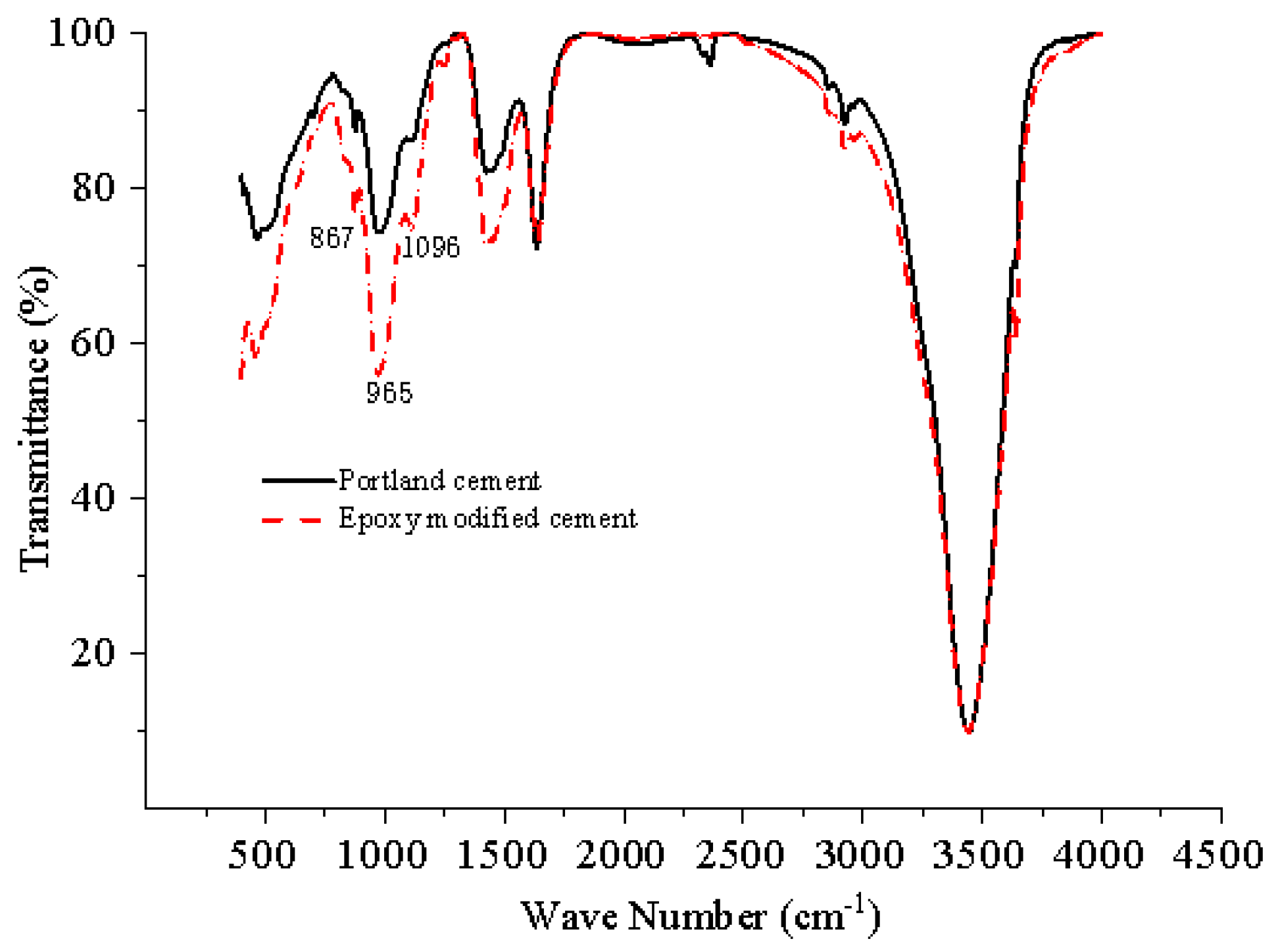
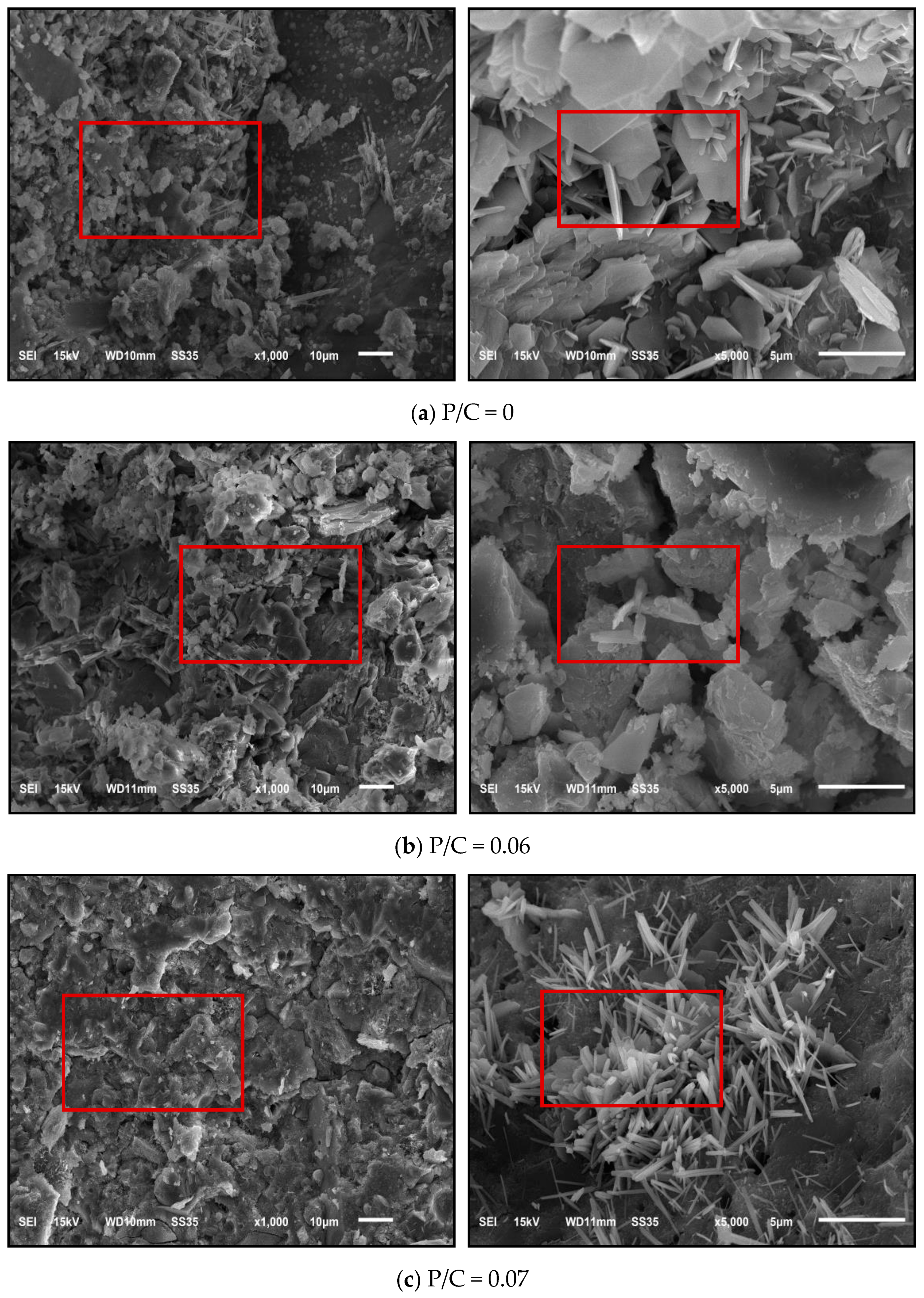
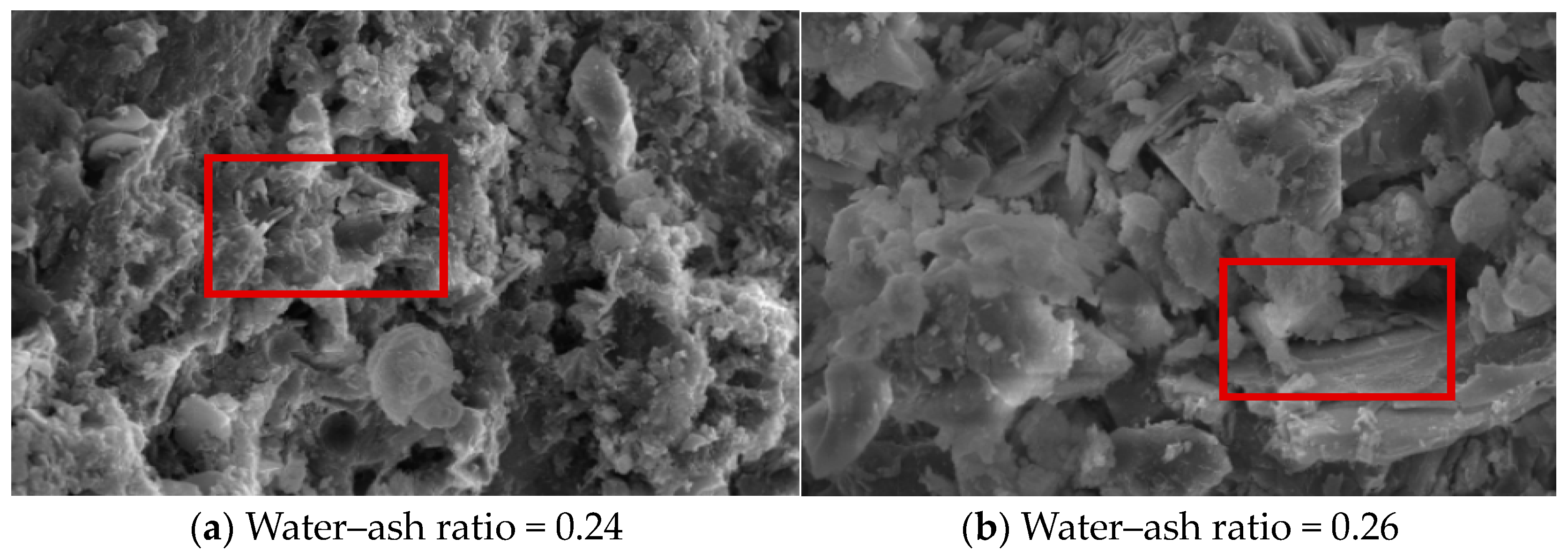

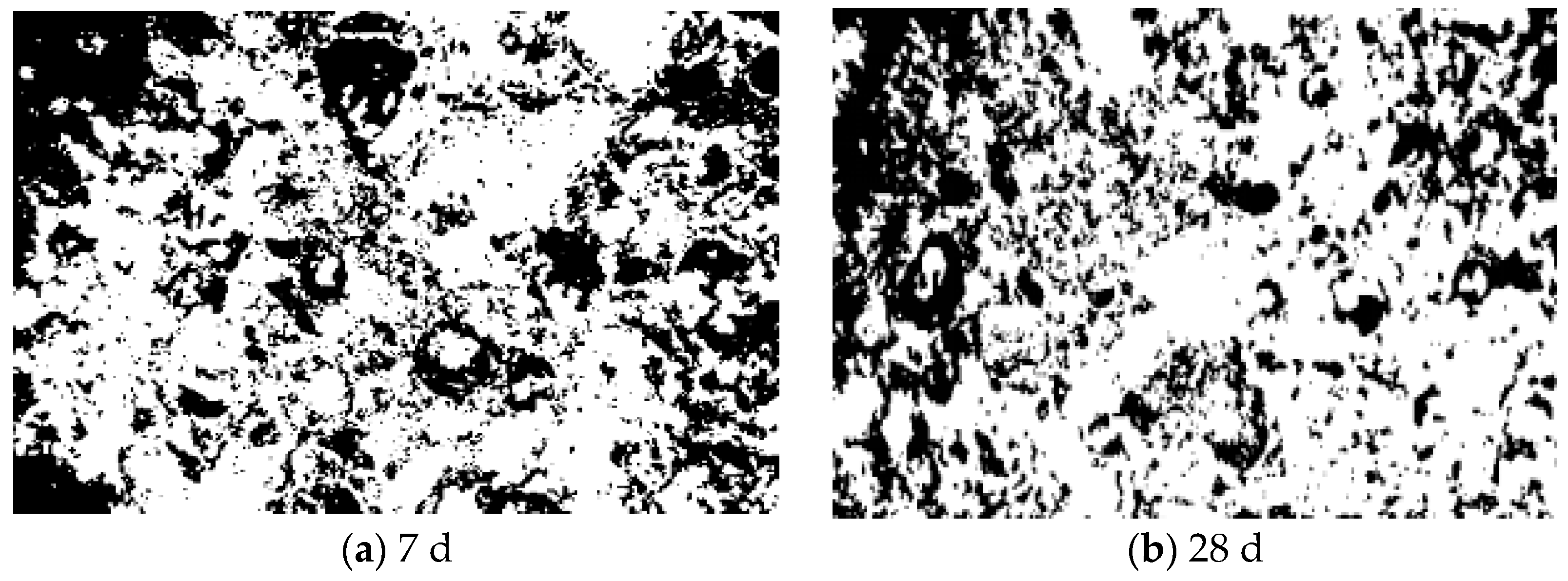
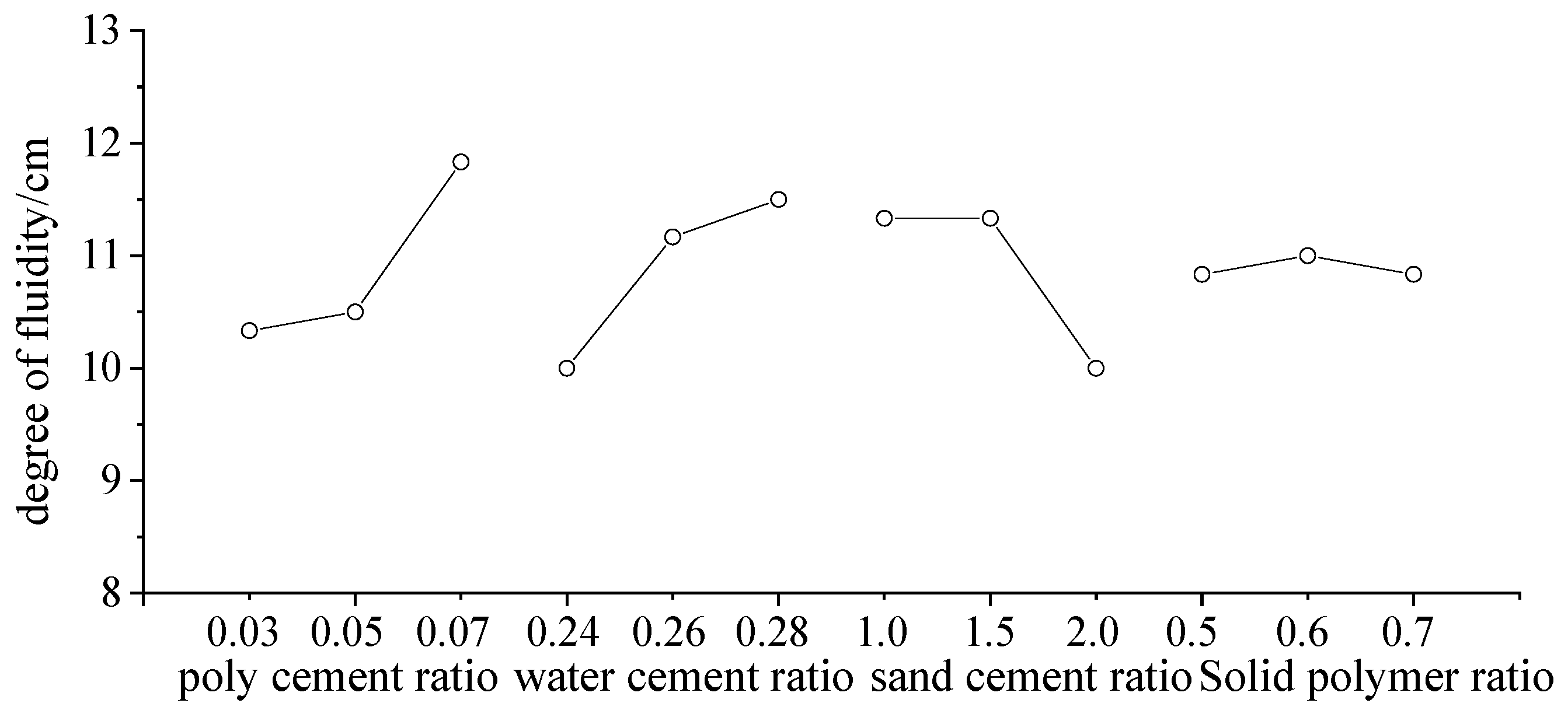

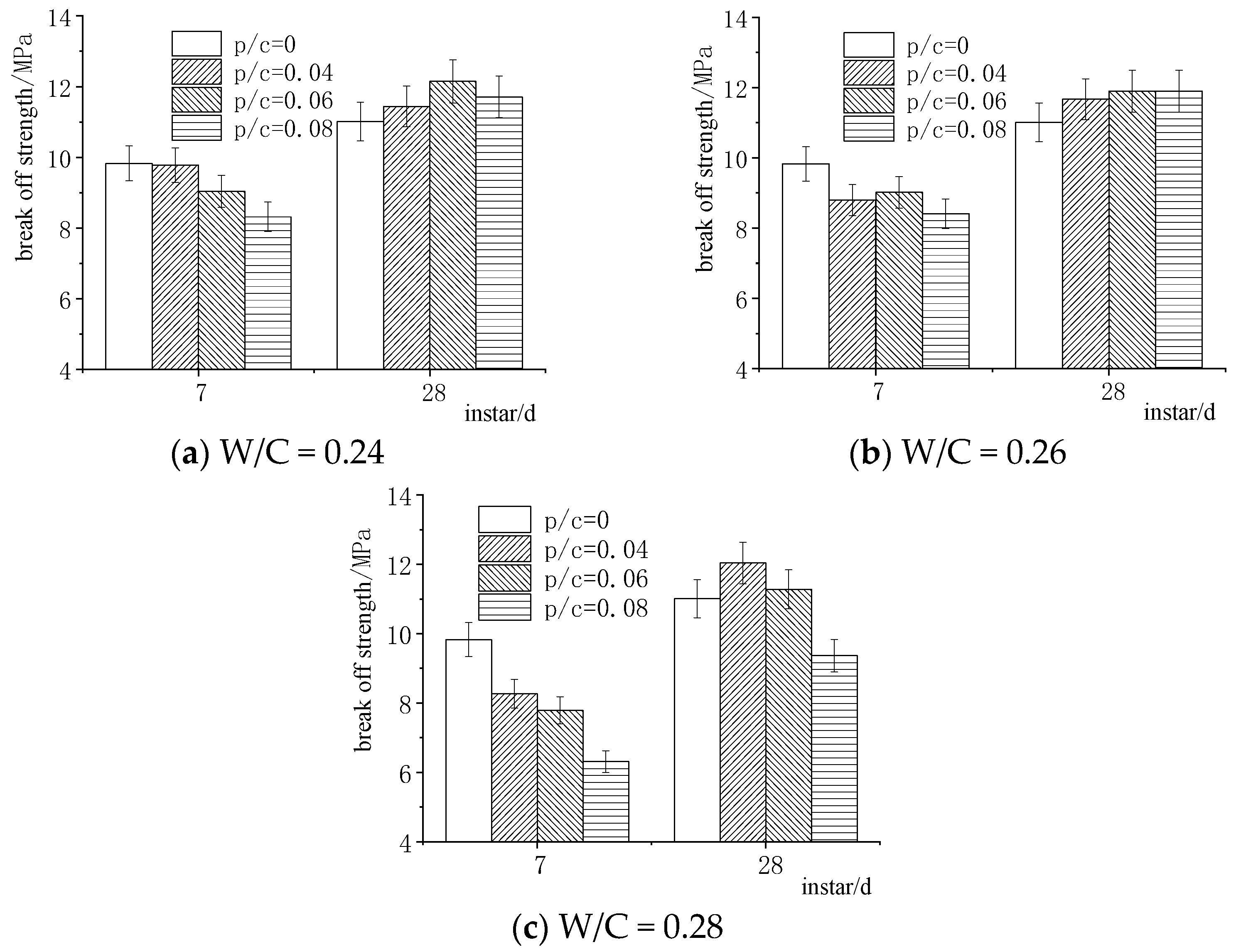

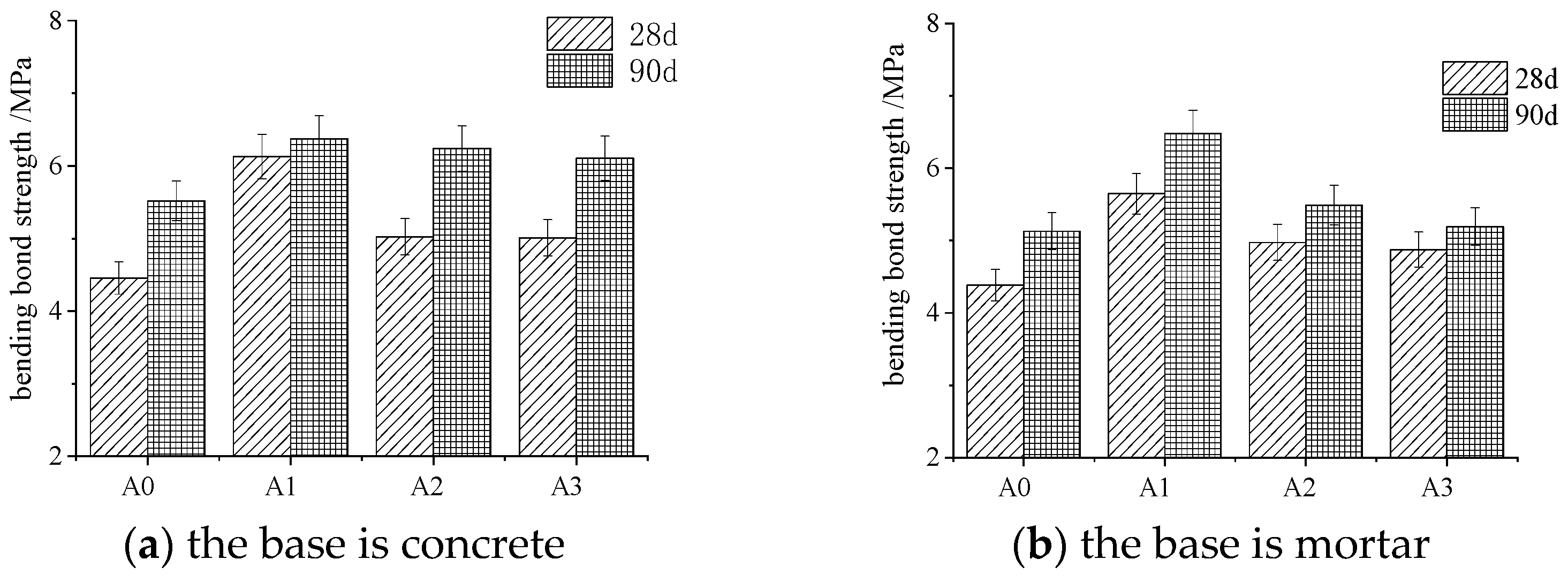
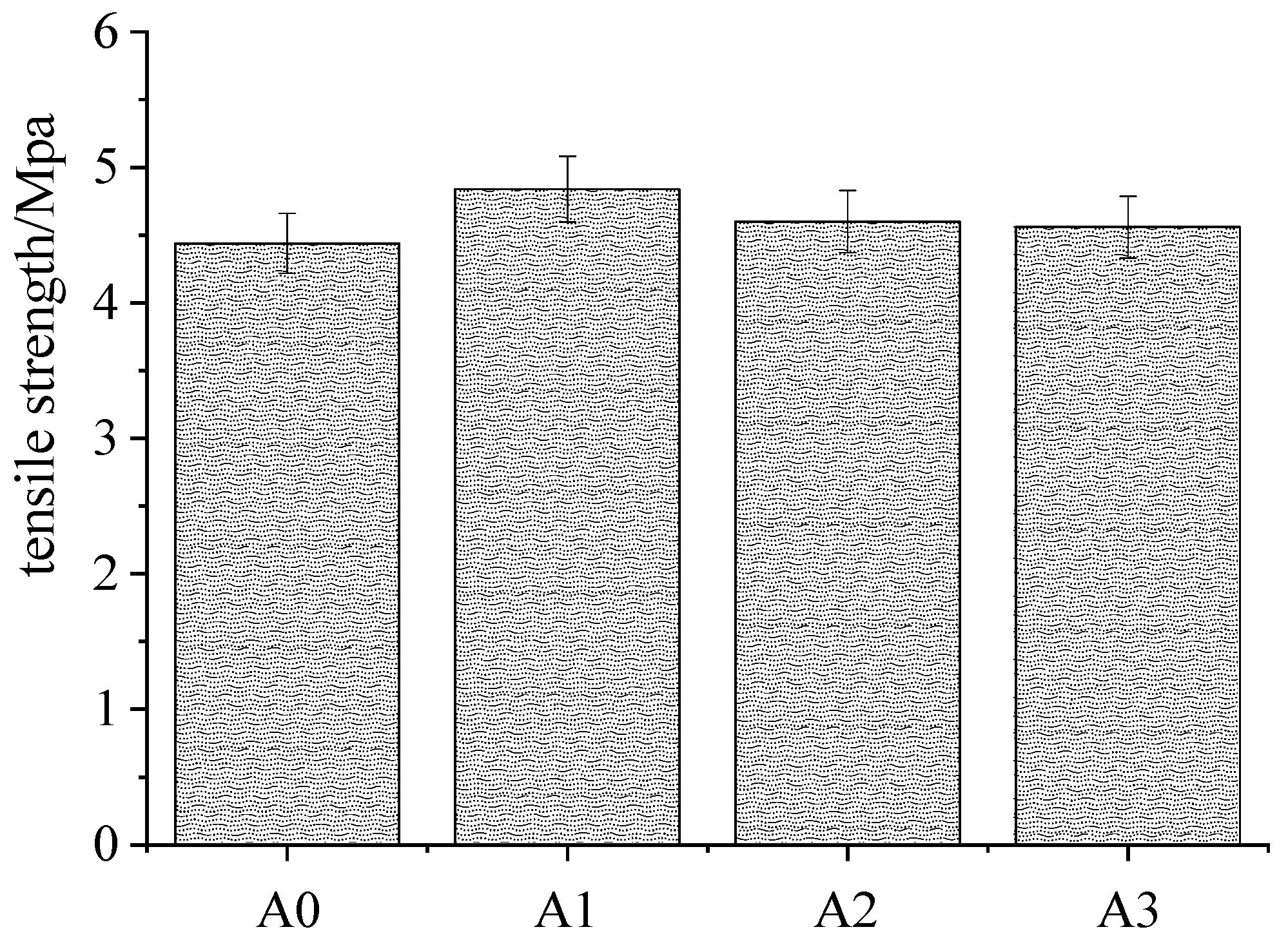
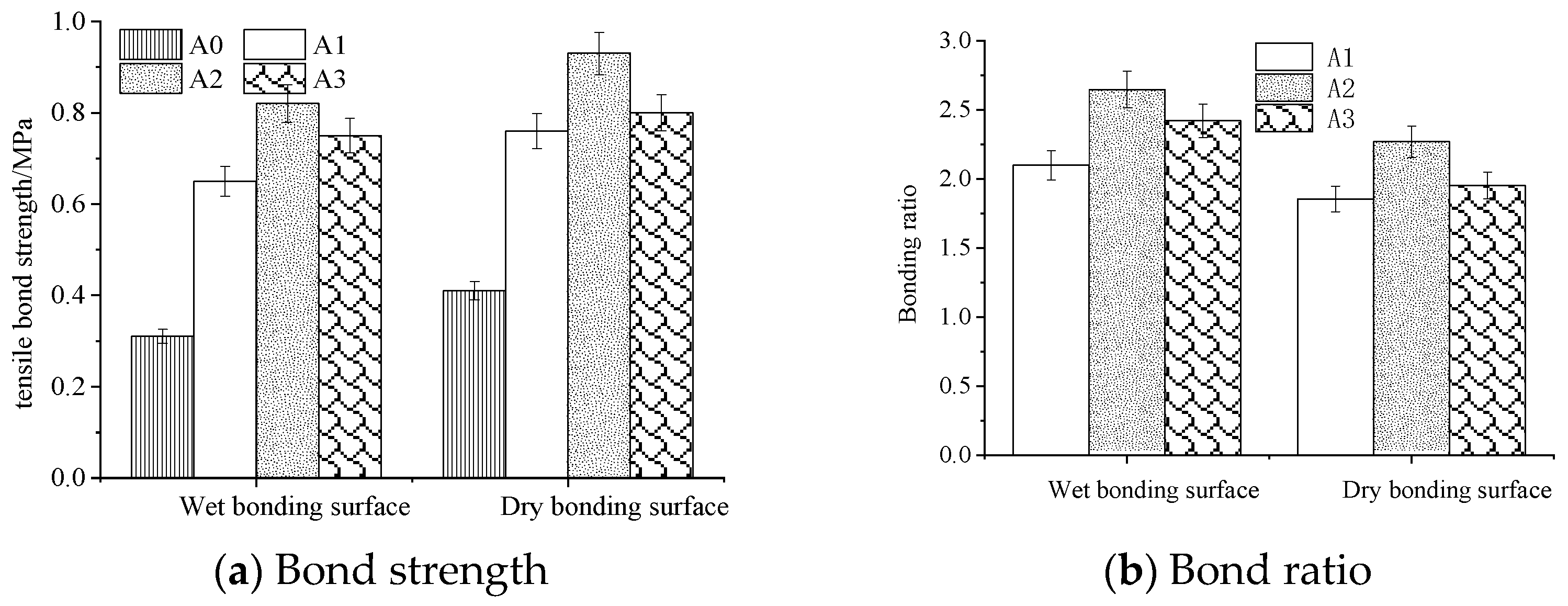
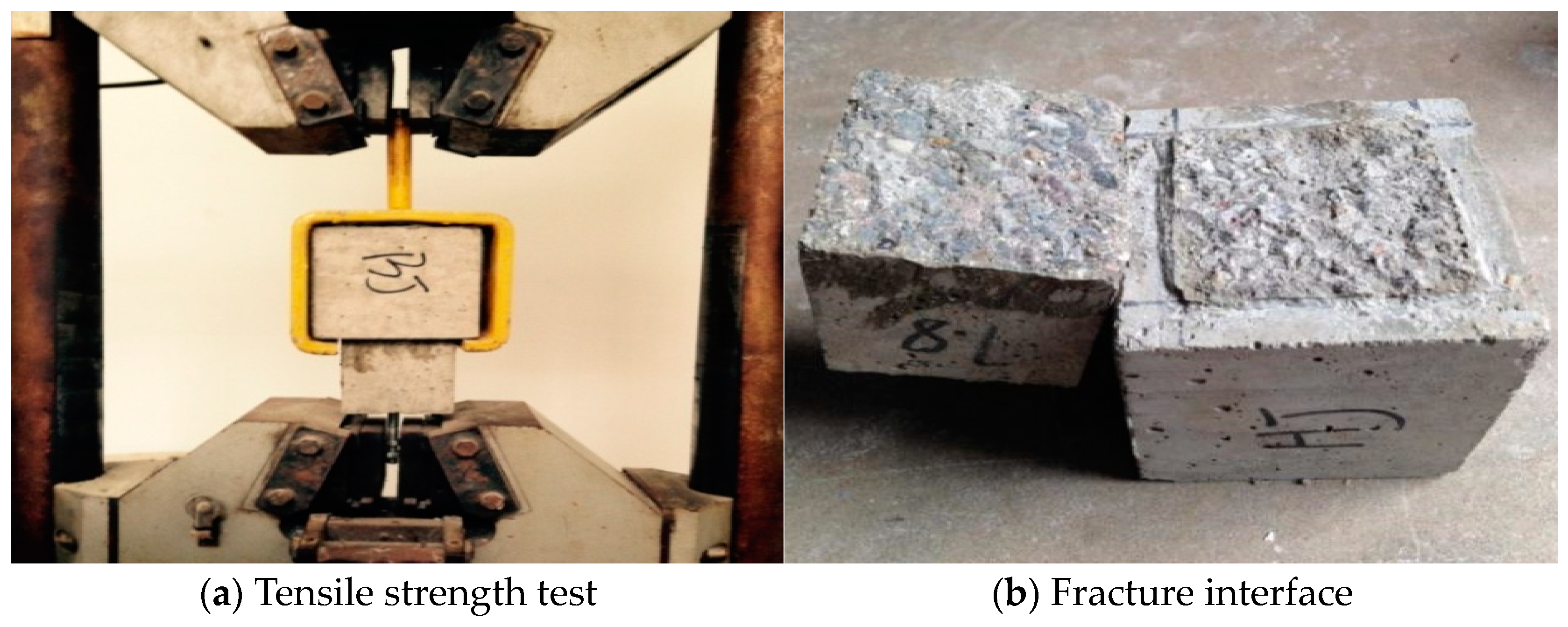
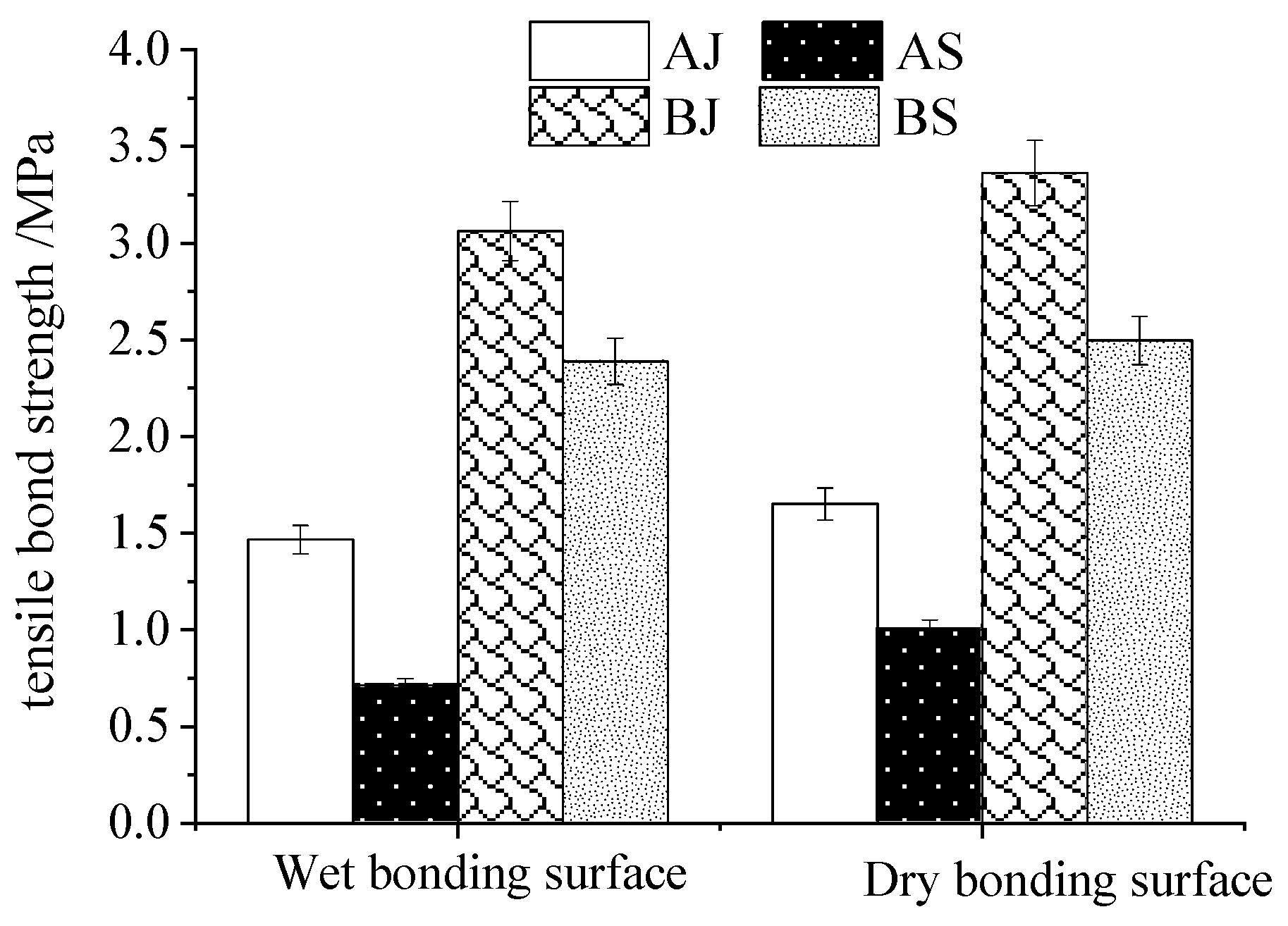
| Factor | Horizontal | ||
|---|---|---|---|
| 1 | 2 | 3 | |
| A (poly ratio) | 1 (0.03) | 2 (0.05) | 3 (0.07) |
| B (water cement ratio) | 1 (0.24) | 2 (0.26) | 3 (0.28) |
| C (sand–ash ratio) | 1 (1.0) | 2 (1.5) | 3 (2.0) |
| D (solid–poly ratio) | 1 (0.5) | 2 (0.6) | 3 (0.7) |
| Serial Number | Poly Cement Ratio | Water Cement Ratio | Sand Cement Ratio | Solid Polymer Ratio | Break off Strength | Compressive Strength | ||
|---|---|---|---|---|---|---|---|---|
| 7 d | 28 d | 7 d | 28 d | |||||
| 1 | X1 | Y1 | Z1 | V1 | 9.25 | 11.62 | 60.78 | 65.83 |
| 2 | X1 | Y2 | Z2 | V2 | 8.72 | 11.99 | 52.64 | 68.66 |
| 3 | X1 | Y3 | Z3 | V3 | 10.13 | 11.39 | 57.17 | 64.18 |
| 4 | X2 | Y1 | Z2 | V3 | 9.47 | 11.85 | 62.69 | 75.88 |
| 5 | X2 | Y2 | Z3 | V1 | 8.24 | 11.23 | 55.81 | 68.36 |
| 6 | X2 | Y3 | Z1 | V2 | 9.89 | 12.10 | 58.62 | 70.66 |
| 7 | X3 | Y1 | Z3 | V2 | 8.86 | 11.85 | 53.39 | 68.07 |
| 8 | X3 | Y2 | Z1 | V3 | 6.26 | 9.32 | 39.48 | 53.89 |
| 9 | X3 | Y3 | Z2 | V1 | 8.27 | 11.66 | 54.64 | 73.79 |
| Performance Index | Category | X | Y | Z | V |
|---|---|---|---|---|---|
| Degree of fluidity (cm) | Mean 1 | 9.833 | 10.426 | 10.833 | 10.333 |
| Mean 2 | 10 | 10.286 | 10.833 | 10.5 | |
| Mean 3 | 11.333 | 9.5 | 9.5 | 10.3333 | |
| range | 1.5 | 0.926 | 1.333 | 0.167 | |
| Setting time (h) | Mean 1 | 133.333 | 148.286 | 160.667 | 170 |
| Mean 2 | 157.333 | 160.143 | 164 | 154.617 | |
| Mean 3 | 184.667 | 158.142 | 150.667 | 154.667 | |
| range | 51.334 | 11.857 | 13.333 | 15.383 | |
| 7 d flexural strength (MPa) | Mean 1 | 9.367 | 9.223 | 8.467 | 8.587 |
| Mean 2 | 9.2 | 8.796 | 8.82 | 9.157 | |
| Mean 3 | 7.797 | 8.731 | 9.077 | 8.62 | |
| range | 1.57 | 0.492 | 0.61 | 0.57 | |
| 7 d compressive strength (MPa) | Mean 1 | 56.863 | 57.300 | 52.96 | 57.077 |
| Mean 2 | 59.04 | 54.305 | 56.657 | 54.883 | |
| Mean 3 | 49.17 | 54.543 | 55.457 | 53.113 | |
| range | 9.87 | 2.995 | 3.697 | 3.964 | |
| 28 d flexural strength (MPa) | Mean 1 | 11.667 | 11.719 | 11.013 | 11.503 |
| Mean 2 | 11.727 | 11.39 | 11.833 | 11.98 | |
| Mean 3 | 10.943 | 11.343 | 11.49 | 10.853 | |
| range | 0.784 | 0.376 | 0.82 | 1.1267 | |
| 28-days compressive strength (MPa) | Mean 1 | 66.223 | 68.807 | 63.46 | 69.327 |
| Mean 2 | 71.633 | 54.542 | 72.777 | 69.13 | |
| Mean 3 | 65.25 | 67.833 | 66.87 | 64.65 | |
| range | 5.383 | 14.264 | 9.3167 | 4.677 |
| Material | AJ | AS | BJ | BS |
|---|---|---|---|---|
| Cement | 560 | 560 | 560 | 560 |
| Expansion agent | - | 16 | 16 | 16 |
| Water-reducing admixture | - | 3 | 3 | 3 |
| Silica fume | - | 10 | 10 | 10 |
| Defoaming agent | - | - | 4.2 | 4.2 |
| Sand | - | 1120 | - | 1120 |
| Epoxy | - | - | 340 | 80 |
| Curing agent | - | - | 170 | 40 |
| Water | 224 | 196 | - | 106 |
Disclaimer/Publisher’s Note: The statements, opinions and data contained in all publications are solely those of the individual author(s) and contributor(s) and not of MDPI and/or the editor(s). MDPI and/or the editor(s) disclaim responsibility for any injury to people or property resulting from any ideas, methods, instructions or products referred to in the content. |
© 2023 by the authors. Licensee MDPI, Basel, Switzerland. This article is an open access article distributed under the terms and conditions of the Creative Commons Attribution (CC BY) license (https://creativecommons.org/licenses/by/4.0/).
Share and Cite
Sun, X.; Zhong, J.; Gao, P.; Li, G.; Xiao, D.; Zhang, Z.; Gan, T. Properties of High-Performance Materials for the Crack Repair of Segment Structures. Sustainability 2023, 15, 15933. https://doi.org/10.3390/su152215933
Sun X, Zhong J, Gao P, Li G, Xiao D, Zhang Z, Gan T. Properties of High-Performance Materials for the Crack Repair of Segment Structures. Sustainability. 2023; 15(22):15933. https://doi.org/10.3390/su152215933
Chicago/Turabian StyleSun, Xuewei, Jianjun Zhong, Peiwei Gao, Guoqing Li, Dingkan Xiao, Zhixiang Zhang, and Ting Gan. 2023. "Properties of High-Performance Materials for the Crack Repair of Segment Structures" Sustainability 15, no. 22: 15933. https://doi.org/10.3390/su152215933
APA StyleSun, X., Zhong, J., Gao, P., Li, G., Xiao, D., Zhang, Z., & Gan, T. (2023). Properties of High-Performance Materials for the Crack Repair of Segment Structures. Sustainability, 15(22), 15933. https://doi.org/10.3390/su152215933





